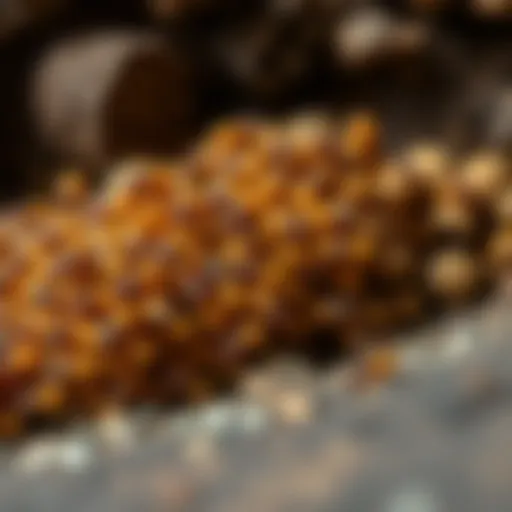Understanding Termite Baiting Treatment: An In-Depth Guide
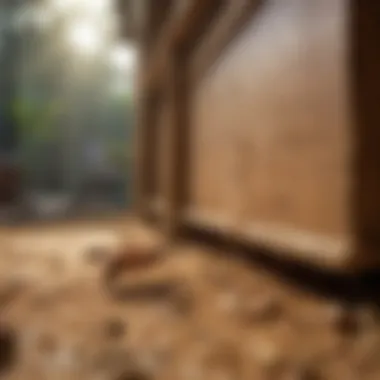

Intro
Termite infestations represent a significant threat to homeowners. These pests can quickly damage structures, leading to costly repairs. Understanding the methods of pest control is crucial, especially termite baiting treatment. This strategy is a more environmentally conscious approach as compared to traditional chemical treatments. In this guide, we will explore what termite baiting entails, why it’s essential, and how it compares with other pest control methods.
Understanding the Pest
Identification
Recognizing a termite infestation is the first step in addressing the issue. Termites are often mistaken for ants due to their similar appearance. However, there are key differences. Termite bodies are more robust and have a uniform width. Their wings are equal in size, unlike ants, which have dissimilar wing sizes. Common species include the Eastern subterranean termite and the Formosan termite. Knowing how to identify these pests can assist in early detection and treatment.
Life Cycle
Termites undergo a complex life cycle comprising three primary stages: egg, nymph, and adult. Eggs hatch into nymphs, which develop into adult termites through a molting process. This cycle can span multiple years depending on the species and environmental conditions. Understanding their life cycle helps in timing baiting treatments effectively to target them at their most vulnerable stages.
Pest Prevention Strategies
Environment Modification
Preventing termite infestations begins with environmental modification. Addressing moisture levels around the home is crucial since termites thrive in humid conditions. Homeowners should ensure proper drainage and avoid water accumulation near foundations. Additionally, reducing wood-to-soil contact can hinder termite access to food sources.
Physical Barriers
Installing physical barriers is another effective method to keep termites at bay. Steel mesh and concrete barriers can be used in the construction phase or during renovations. These barriers create a physical blockade against termite entry, making it a proactive solution.
Control Methods
Chemical Control
Chemical treatments have long been the go-to for termite infestations. However, these methods often focus on applying termiticides in the soil around a structure. While effective, they pose ecological risks and potential health hazards for inhabitants. Therefore, alternatives like baiting systems gain attention.
Biological Control
Biological control involves the use of natural predators and pathogens to manage termite populations. Recently, researchers have begun advocating for this method as it offers a sustainable long-term solution. Fungal pathogens, for example, can infect termites, leading to a decline in their numbers significantly. Incorporating these bio-controls can create a balanced ecosystem and support ongoing pest management efforts.
"Understanding termites and their control methods goes beyond mere identification; it is about comprehensive management and prevention strategies that protect your home."
As we delve deeper into the specific aspects of termite baiting treatment, this foundational knowledge will arm homeowners with a clearer understanding of the measures needed to combat these destructive pests.
Prolusion to Termite Baiting Treatment
Termite baiting treatment is a proactive approach in the field of pest management. It focuses on placing bait around a structure, aiming to lure and eradicate termites. Understanding this method is crucial for homeowners concerned about termite infestations. These pests can cause significant damage to properties, and early intervention can save one from extensive repair costs and emotional distress.
Definition of Termite Baiting
Termite baiting involves the strategic placement of bait stations around the perimeter of a property. The bait is designed to attract termites, which consume it and then share it with their colony. This indirect ingestion leads to the weakening or elimination of the entire colony over time. Baits usually contain slow-acting insecticides or biological agents that are less harmful to the environment compared to conventional chemical treatments.
Importance in Pest Management
The significance of termite baiting treatment lies in its targeted approach and minimal ecological footprint. Unlike barrier treatments that involve heavy chemical applications to the soil, baiting systems focus on the specific areas where termites are active. This helps to reduce the overall exposure to chemicals, making it safer for the inhabitants and the surrounding environment.
Moreover, baiting systems allow for ongoing monitoring of termite activity. Homeowners can attach bait stations to check if termites are present and if the bait is effective. This form of long-term pest management is advantageous because it addresses the problem before it escalates into a major infestation.
"Termite baiting treatment not only targets the pests directly but also empowers homeowners with knowledge about their pest control strategy."
Understanding Termites
Understanding termites is a crucial aspect of effectively managing termite infestations. This section highlights their biology, behavior, and the damage they can cause. Awareness of these factors helps homeowners devise better strategies for prevention and control, especially in relation to baiting treatment.
Biology of Termites


Termites are social insects that belong to the order Blattodea, which also includes cockroaches. They are characterized by their caste system, consisting of workers, soldiers, and reproductive individuals. Workers are responsible for foraging, while soldiers defend the colony. The reproductive caste includes the queen and king, tasked with producing offspring.
A unique feature of termites is their symbiotic relationship with protozoa and bacteria in their guts. These microorganisms enable termites to digest cellulose found in wood, making them efficient decomposers. This ability is essential for their survival, and their feeding habits directly align with the damage they can inflict on wooden structures.
Types of Termites and Their Behavior
Several species of termites exist, but they can primarily be categorized into three groups: subterranean, drywood, and dampwood termites.
- Subterranean Termites: These live in the soil and build complex tunnels to access wood above ground. They are the most common type in the United States and can cause significant damage as they prefer to nest in moist environments.
- Drywood Termites: Unlike subterranean species, drywood termites can live in dry wood, requiring no contact with soil. This makes them particularly troublesome as they can infest furniture and structural wood without being detected until considerable damage has occurred.
- Dampwood Termites: These prefer decaying wood and are often found in humid locations. They are less aggressive than the other types, but can still lead to structural concerns.
Termite behavior varies across species but generally revolves around efficiency in feeding and reproduction. They establish colonies that can number in the millions, contributing to their collective ability to damage properties.
Damage Caused by Termites
The damage caused by termites can be extensive and often goes unnoticed until significant structural issues arise. Their feeding habits can lead to:
- Structural Damage: Termites can compromise the structural integrity of buildings, leading to potential safety hazards. In homes, this might affect flooring, walls, and beams.
- Cost Implications: Repairs from termite damage can be expensive. Homeowners may face costs over thousands of dollars if infestations are not caught early.
- Hidden Damage: While termites are active, the damage is often concealed within walls or under floors, making detection difficult without proper inspection.
"Termites can cause serious structural damage undetected for years, highlighting the need for vigilant monitoring and treatment strategies."
Understanding the nuances of termite biology, their various types, and the potential damage they cause underscores the need for effective management strategies, including baiting treatments, to mitigate these risks. This foundational knowledge sets the stage for discussing termite baiting systems and their application in pest management.
Principles of Termite Baiting Systems
Termite baiting systems represent a sophisticated approach to controlling termite populations. This method relies on a few key principles that are essential to its effectiveness. Understanding these principles helps homeowners appreciate the rationale behind baiting treatments and their advantages over conventional methods.
Baiting systems use a targeted strategy, primarily designed to lure and eliminate termites before they can cause significant damage. Here, we delve into the mechanics of how these systems work and the specific ingredients that ensure their effectiveness.
How Baiting Works
The fundamental principle of termite baiting involves placing bait stations strategically around a property. These stations contain materials that attract termites. Once termites discover the bait, they feed on it and carry it back to their colony. This process leads to the slow and deliberate extermination of the entire colony. The systemic nature of this approach distinguishes it from other methods, which typically only treat the visible infestations.
The bait works over time, allowing termites to ingest the active ingredients and share them with other colony members, including the reproductive individuals. This helps in disrupting the life cycle of termites, leading to a gradual decline in their numbers. Overall, this method promotes a more sustainable solution to pest control.
Active Ingredients in Baits
The success of termite baiting relies heavily on the choice of active ingredients. There are two primary categories of active substances used in baits. Insect growth regulators like methoprene and hydroprene disrupt the molting process of termites. This prevents them from maturing properly, leading to a decrease in their population over time.
Another class of active ingredients includes non-repellent insecticides. These include fipronil and chlorantraniliprole, which are lethal to termites but have minimal impact on non-target organisms when used correctly. This selectivity contributes to the overall safety of baiting treatments, making them attractive for homeowners concerned about pesticide exposure.
Mechanics of Termite Ingestion
For baiting systems to be effective, understanding how termites ingest food is crucial. Termites primarily feed through a process called trophallaxis, where they exchange food and liquids with each other. This behavior is significant as it allows the bait to spread throughout the colony. Once a termite consumes the bait, it can share it with others, facilitating further exposure to the active ingredients.
This method captures not just the workers but also the queen and the nymphs in the nest, leading to a more comprehensive form of extermination.
Key Insight: The ability of termites to share food means that baiting systems can effectively target the entire colony over time, rather than just the visible termites.
Moreover, the bait’s formulation is designed to mimic the natural food sources of termites, ensuring they are attracted to the stations. A well-thought-out bait strategy recognizes these behaviors and enhances the likelihood of comprehensive effectiveness.
Through these principles, termite baiting systems emerge as a reliable option for homeowners looking to safeguard their properties from the damaging impact of termites. Proper implementation and monitoring further enhance the benefits and effectiveness of this treatment.
Advantages of Termite Baiting Treatments
The advantages of termite baiting treatments are multifaceted, contributing substantially to their appeal as an effective pest management strategy. As homeowners and professionals increasingly seek sustainable solutions, understanding these benefits helps illuminate why baiting systems become popular.
Targeted Approach
One of the most significant advantages of termite baiting is its targeted approach. Unlike traditional methods that may involve widespread spraying of pesticides, baiting focuses specifically on areas where termite activity is detected. This precision minimizes the impact on non-target species and enhances the effectiveness in eradicating the pest. By directly addressing the colonies, baiting can be a more efficient solution, effectively disrupting the lifecycle of the termites without unnecessary exposure to chemicals in areas where infestations are not present.
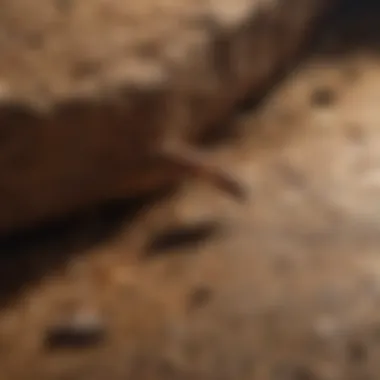

Reduced Chemical Exposure
Reduced chemical exposure is another crucial benefit of using termite baiting treatments. These systems typically use lower concentrations of active ingredients compared to conventional treatments. Homeowners often express concerns about the potential health risks of chemical residues in their environments. With baiting systems, such worries are alleviated as the baits are located strategically away from living spaces. This reduction in chemical usage not only protects families and pets but also contributes to better ecological outcomes by minimizing harmful runoff into the surrounding environment.
Long-Term Monitoring Capabilities
Long-term monitoring capabilities are inherent to the design of termite baiting systems. Many bait stations include features that allow for the ongoing assessment of termite activity. This continuous monitoring provides critical insights for homeowners and pest management professionals. Regular checks can reveal new infestations before they become severe, facilitating timely interventions. As a result, pest management can shift from a reactive approach to a more proactive one, ensuring the property remains protected over time. Additionally, the data collected can inform future treatment decisions, enhancing overall effectiveness.
Baiting systems offer a strategic advantage, reducing chemical exposure while providing insights into pest activity, making them an efficient choice for termite control.
Limitations and Challenges
Understanding the limitations and challenges of termite baiting treatment is crucial for homeowners and professionals in pest management. While baiting is a sophisticated method with many advantages, it also comes with certain constraints that can affect its effectiveness and overall value in pest control strategies. A balanced view helps in making informed decisions and utilizing termite baiting systems to their full potential.
Time-Intensive Process
One significant limitation of termite baiting systems is that they require time to be effective. Unlike traditional chemical treatments, which can eradicate termites quickly, baiting systems often take several months to achieve desired results. The design of bait stations calls for regular checks and monitoring of bait consumption. This process can be labor-intensive, requiring technicians to ensure that the bait remains attractive and that termites are actively feeding on it.
Homeowners may find this time frame frustrating, especially if they expect immediate relief from a burgeoning infestation. It’s important to note that the delay in results doesn’t equate to ineffectiveness. The gradual approach enables the population to be targeted specifically, but it does mean that patience and commitment are required.
Cost Considerations
Another crucial challenge relates to the cost of implementing termite bait systems. On average, termite baiting may require a higher initial investment compared to traditional treatments. The baits, components, installation charges, and ongoing monitoring can add up. Many homeowners might not be completely aware of the full cost structure. While it may seem like a more expensive option, many do not realize it offers long-term solutions that can ultimately save money by preventing future infestations.
To maximize the value of baiting, it's critical to assess whether the cost aligns with the extent of the termite problem. Homeowners should consult pest management professionals to understand the long-term benefits versus initial expenditures. Evaluating the potential for future damage from untreated termite infestations adds another layer of complexity to this financial consideration.
Potential for Bait Aversion
Bait aversion is an obstacle that can undermine the efficiency of termite baiting systems. Termites can exhibit behaviors that lead them to avoid certain baits after initial exposure. This aversion can emerge from previous experiences or learned behaviors, leading to the possibility that termites may reject bait after having fed on it.
Monitoring bait stations is crucial to identify any signs of rejection. If bait aversion occurs, it may necessitate adjustments to the bait composition or a change in strategy. This situation emphasizes the importance of regular monitoring and updates on bait stations.
Bait aversion can severely hinder the efficacy of baiting systems, making it essential for homeowners to stay vigilant and engaged with their pest management strategies.
Understanding these limitations and challenges highlights the need for careful planning and communication between homeowners and pest control professionals. Emphasizing awareness about these constraints can foster a more proactive approach toward termite management while making the most of the benefits that baiting systems can provide.
Baiting vs. Traditional Treatment Methods
The ongoing debate between termite baiting and more traditional treatment methods is crucial in understanding how best to manage pest control in residential settings. Both methods have their advantages and limitations, influencing homeowners' choices based on their specific needs. This section examines the effectiveness and ecological implications of these approaches in detail.
Comparison of Effectiveness
When evaluating the effectiveness of termite baiting systems against traditional chemical treatments, several factors come into play.
Termite Baiting:
Typically, termite baiting involves strategically placed bait stations that contain slow-acting and toxic formulations. These baits target the social structure of termite colonies, allowing for a more comprehensive eradication approach. Since the bait is carried back to the colony, this method effectively reduces the population over time. Nevertheless, results may take weeks or even months to manifest, which some homeowners may find unsatisfactory.
Traditional Treatments:
In contrast, traditional methods, such as liquid pesticide applications, often provide immediate results. These involve the application of chemicals directly to the soil and wood structures, creating a barrier against termites. However, they come with their own set of disadvantages, including potential chemical runoff and exposure to non-target organisms.
An effective treatment should consider the severity of the infestation, the surrounding environment, and personal preferences concerning chemical exposure. Homeowners might choose baiting for long-term safety and sustainability, while relying on traditional methods for quicker, immediate results.
Ecological Impact Assessment
Assessing the ecological impact of termite management strategies is vital to making informed decisions.
Termite Baiting:
From an ecological standpoint, baiting systems typically present a lower risk to the environment. The targeted application reduces the overall use of chemicals, minimizing potential harm to beneficial insects and other organisms. Furthermore, constant monitoring of bait stations allows for adjustments, helping to maintain a healthy ecosystem.
Traditional Treatments:
On the other hand, traditional pest control methods often involve broader chemical applications that can have far-reaching consequences. Pesticides may leach into soil and water systems, risking the health of local wildlife. Homeowners also experience concerns about the safety of extended chemical exposure within their living space.
Adopting eco-friendly practices can inform the decision-making process for pest control, making it essential to quantify these ecological effects when choosing a treatment method. In summary, termite baiting presents a more sustainable option than traditional treatment methods, albeit one that requires patience and consistent monitoring.
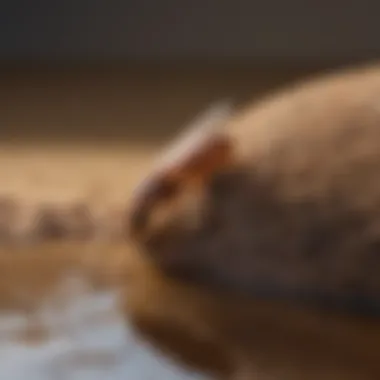
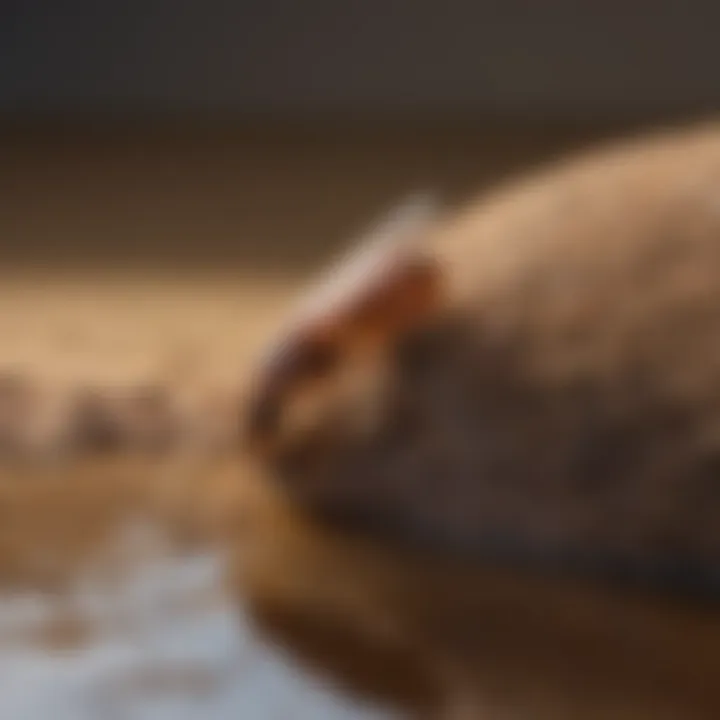
Best Practices for Implementing Baiting Systems
Effective termite baiting treatment requires not just the right products, but also the right methods. Implementing best practices ensures that the system works optimally and provides long-lasting results. This section outlines critical elements for successful baiting, from initial assessments to ongoing monitoring.
Site Assessment and Planning
Before any baiting system is installed, a thorough site assessment is essential. This helps in understanding the specific conditions of the property and its potential vulnerabilities to termite infestions. During this assessment, it is important to evaluate:
- Moisture levels: Termites thrive in moist environments. Identify sources of moisture around the home, such as leaky pipes or poor drainage.
- Wood sources: Check for wood-to-soil contact in structures. This can include deck posts, fence posts, and even mulch.
- Access points: Look for entry points that termites may use to get into the structure.
Planning should involve creating a tailored baiting strategy that considers these factors. This might include determining the number and locations of bait stations to maximize exposure to foraging termites.
Installation Techniques
Correct installation is crucial for the effectiveness of baiting systems. Poorly installed bait stations can lead to inadequate termite control. Here are some important installation techniques:
- Distance between stations: Install bait stations at optimal distances, typically every 10 to 20 feet around the perimeter of the home, depending on the level of termite activity in the area.
- Depth placement: Bait stations should be placed below the ground surface, usually 6 to 8 inches deep, to attract subterranean termites effectively.
- Use of attractants: Incorporating attractants can increase the likelihood of termites finding the bait. This may include wood or cellulose materials that are appealing to termites.
Proper sealing and protection of bait stations from environmental factors will also prolong their effectiveness.
Monitoring Strategies
Monitoring is an ongoing process that is vital for assessing the effectiveness of the baiting system. Here are some strategies to implement:
- Regular inspections: Check the bait stations monthly during the first year. This frequency can reduce to quarterly checks afterward if termite activity is low.
- Record findings: Maintain detailed records of any activity seen in the bait stations, such as the presence of termites or the consumption of bait. This information is critical for determining when to replace bait or adjust strategies.
- Evaluate surrounding areas: Keep an eye on potential problem areas outside the bait system as well, as this can provide insight into broader infestation issues.
Regular monitoring allows homeowners to identify potential problems early, thus preventing extensive damage to the property.
By incorporating these best practices into the implementation of termite baiting systems, homeowners can significantly enhance the effectiveness of their termite control efforts. Through careful planning, professional installation, and vigilant monitoring, the risks posed by termites can be managed more effectively.
Future Innovations in Termite Baiting
The field of termite baiting treatment is evolving rapidly, driven by the need for effective, sustainable pest control methods. Emerging innovations are reshaping how homeowners and professionals approach termite management. These developments not only enhance the effectiveness of treatments but also contribute to minimizing the ecological footprint associated with pest control.
Emerging Technologies
Recent advancements in technology have led to the creation of smarter baiting systems. These systems utilize sensors and real-time data to monitor termite activity more effectively. For example, some systems now include remote monitoring capabilities, allowing users to track the status of bait stations from their smartphones. This level of access ensures that homeowners are promptly informed about any termite activities, enabling quick and decisive action.
Additionally, advancements in bait composition are noteworthy. Researchers are developing baits that are more appealing to termites, which increases the likelihood of consumption. Some of these baits are made from natural ingredients, which present a lower risk to non-target species. This can be particularly important for homeowners who have pets or nearby wildlife.
Research Trends and Developments
Research in the field of termite management is focusing on the long-term effects of baiting treatments. Studies are being conducted to understand how certain active ingredients function within the termite colony. Researchers are exploring thorough ways in which bait affects not just the foraging termites, but also the members of the colony that remain underground, potentially leading to more effective eradication methods.
Moreover, interdisciplinary collaboration is enhancing these developments. Experts from fields such as molecular biology and ecology are exploring the genetic makeup of certain termite species. Understanding these genetic factors can lead to the development of targeted treatments, which minimize the impact on surrounding ecosystems. By investing in research, the pest control industry can identify innovative solutions that could make traditional methods obsolete.
"Innovative technologies in termite baiting treatment hold promise for more efficient, less harmful pest management."
In summary, innovations in termite baiting treatment are showing great potential. As technologies emerge and research continues, the effectiveness and safety of these methods are expected to improve. Homeowners can look forward to more sophisticated options that not only eliminate pests but also respect the environment.
Ending: The Role of Baiting in Integrated Pest Management
In the realm of pest control, the strategic use of termite baiting treatments holds significant value. The methodology represents an efficient and environmentally considerate approach within integrated pest management. Unlike traditional methods, which often rely heavily on chemical pesticides, baiting systems aim to minimize chemical exposure while effectively eliminating termite colonies.
Summarizing Key Insights
Understanding the role of baiting in pest management first involves recognizing its specific benefits. Baiting systems can target specific species of termites, reducing collateral damage to non-target organisms. This specificity is crucial, as it allows for greater ecological balance and less disruption to the local ecosystem.
Another vital insight is the long-term monitoring capabilities that baiting systems provide. By regularly monitoring bait stations, homeowners and pest control professionals can assess termite activity over time. This data aids in early detection of infestations and evaluation of treatment effectiveness. Furthermore, baiting treatment encourages ongoing collaboration between professionals and homeowners, fostering an informed approach to pest management.
Final Considerations for Homeowners and Professionals
For homeowners considering termite baiting, it's essential to weigh the advantages against potential limitations. While baiting can be more eco-friendly and targeted than conventional methods, it also requires patience and commitment. Results can take time to manifest, and ongoing monitoring is necessary to ensure success.
Professionals in pest management should stay updated on emerging technologies and trends in termite baiting. Continuous education will further improve treatment efficacy and adapt to changes in termite behavior or resistance patterns. The final remark for both homeowners and professionals is to prioritize communication and proactive strategies. By working together, they can enhance the effectiveness of termite baiting and contribute to sustainable pest management solutions.







